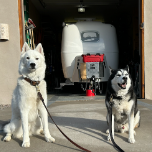-
Posts
163 -
Joined
-
Last visited
-
Days Won
1
Dave and Kimberly last won the day on April 8
Dave and Kimberly had the most liked content!
My Info
-
Gender or Couple
Couple
-
Location
Bellefontaine, Ohio
My RV or Travel Trailer
-
Do you own an Oliver Travel Trailer, other travel trailer or none?
I own an Oliver Travel Trailer
-
Hull #
1097
-
Year
2022
-
Make
Oliver
-
Model
Legacy Elite II
-
Floor Plan
Twin Bed Floor Plan
-
What model is your other RV or Travel Trailer?
Legacy Elite II
Recent Profile Visitors
3,048 profile views
Dave and Kimberly's Achievements
-
So , at least in my case and several others... they are taking care of the Truma recall repair at the rally. Jason has just called to confirm they have the parts set aside and that they will be taking care of it there. That is just great service from Oliver in my opinion! Can't wait to see everyone there!!
-
I contacted Oliver about 7~8 weeks ago and spoke with Jason (the new one) and we tentatively planned to do my recall repair at the rally. The biggest hold-up was simply getting the replacement parts from Truma. He asked me to call back a time or two in March to get updates on A) the parts status and B) whether Oliver was going to have a "Rally" repair team to do these repairs. Coincidently just today was the second time I've called them back and neither time have they responded one way or the other. I'm still hoping they can do it at the rally. Jason said the whole process was only 30~45 minutes at most. Ours is and always has worked fine with no indication of a problem... but with some extra caution and awareness I plan to use it until the parts are replaced. As I understand it the burner bracket "may come loose"... in certain situations.
-

Weigh Safe 180 Aluminum hitch with 3” shank, 10” drop
Dave and Kimberly replied to Patriot's topic in Towing an Oliver
Thanks for the quick response and information! Yes... we are going to be at the rally this year (site E-03) and only the second time we've been able to make it since we were there in 2022 right after buying our Oliver. We are almost as excited to get this new truck as we were to get the Oliver! We won't have it at the rally though... delivery isn't until late May... but trying to line up all our truck bling so that we can have it all ready! Also getting a Smartcap Adventure to keep our gear a bit more protected back there. Lets be sure to hook up because I have lots of questions... and you can tell me all about your Alcan springs also! (I have to say this carefully so as not to get another 20+pages started on the subject 🤣) We CAN NOT WAIT to see everyone at the rally again!! -

Weigh Safe 180 Aluminum hitch with 3” shank, 10” drop
Dave and Kimberly replied to Patriot's topic in Towing an Oliver
Patriot- I did a search and your post was exactly what I was looking for! I'm upgrading my truck to an F-250 Super duty Lariat 6.7L Diesel...and I was considering exactly the hitch you bought. Because I don't have the truck yet... I can't measure it up to determine which "drop" to get and ensure our Ollie rides nice and flat. Did you need the 10" drop to make that happen... or do you just have multiple trailers that require it? I see that the hitch comes in several drops... 6", 8" and 10" drops also. -
WELCOME Jason! We look forward to working with you and good luck in your new position!
-

Switch in bathroom - what does it do?
Dave and Kimberly replied to GreenFlash's topic in Mechanical & Technical Tips
Its one part of whats called a 3 WAY switch. Just like in your house where you can turn a light on/off from opposite sides of the room... this allows you to turn the water pump on from either the wall above dinette OR from the bathroom. -
I'm thinking that my next truck will be an F-250 super duty diesel. I understand all the benefits (pay load, braking, handling and elimination of the WDS) There is a significant cost up ($10K) for the diesel engine alone. Ive read enough folks opinions on the diesel engine and I'm convinced that it is better for towing. My current F-150 just never gets any more than 13mpg... and thats generally a good day! A question to the many of you folks that have made the leap to diesel; what kind of milage are you getting while towing your Ollie?
-

Traveling with water tank full
Dave and Kimberly replied to aaronorange's topic in General Discussion
It's clearly (by the comments already) a matter of preference. We like to always leave home (or one campsite to the next) with full fresh and empty black and gray. For one thing we like having our nice water from home in tank, but we also invariably use our bathroom along the way. Regarding drinking from it... we do, but also carry a Brita water gizmo in the fridge. So even our water is filtered once more from tank for our coffee and drinking water. There have been times when I left one campsite and planned on having water at the next site... so I didn't fill up my fresh. Then our plans changed and I found myself boon-docking without that water in my fresh tank... so now it's just my rule: full fresh, empty black and gray no matter what, I just do it. -

Trip Planning - Wow to the Power of Wow
Dave and Kimberly replied to HDRider's topic in Campgrounds & Parks
HD... I feel your pain. I too loved taking off on my motorcycle and just catching a hotel somewhere along the way... with little or no planning except a "general direction" in mind. That said... I've learned with the Ollie how to be nearly as spontaneous by becoming more and more aware of the Ollie's capabilities... AND I CAN SLEEP IN MY OWN BED EVERY NIGHT. It's also much cheaper than decent hotel rooms at today's prices! It's taken us a couple of years... and now with nearly 270 nights in our Oliver to get used to how to maximize all of it's strengths. As you learn how long your fresh, gray and black tanks last (the way you travel), you start to learn just how "free" you are. If you are just traveling, trying to get somewhere, a Walmart or Cracker Barrel work great because they are nearly everywhere. It's also very nice to have, besides your rolling hotel room... a rolling restaurant with great food and snacks, and a clean bathroom when the moment strikes. Let's not even talk about that quick nap! The Oliver is so self contained and easy to get in and out grocery store parking lots, fast food joints, gas stations, small towns and side streets, etc., that you will come to appreciate the amenities of your Oliver. It's also easy to get in to campsites that many would not be able to. Regarding planning; it takes a certain amount of planning to go see and spend time in those destination "hot spots" that we've always wanted to see. What we have found works best for us is to anchor your trip with reservations in those places that just require it... but allow time in between those hot spot reservations to be spontaneous (that place the locals told you you just can't miss!), time for medical or mechanical emergencies and to just allow time to shop for groceries and do the laundry. Of course I'm saying all of this and assuming that you don't have too many time constraints. If you are still working you can throw out everything I just said! 🙂 If you ever took Stephen Covey's class on "Seven Habits of Highly Effective People"... all of this reminds me of the "lesson" of putting in the big rocks in the jar first (the things that really matter) ... and then sprinkle in the little rocks (smaller things that are fun... but maybe not absolutely necessary). Travel is fun, but I don't like it to be so much like work. I'm done with schedules and self inflicted constraints to be somewhere at a certain time. Time to relax, enjoy, be surprised... and stop in at that store in the mountains that serves awesome huckleberry pie and ice-cream.- 6 replies
-
- 10
-

-

-

-
GJ... the "red light" on the battery blanket switch is all I am going by. And I agree that the true test is to measure any draw going to that blanket independent of the red light. While I have the electrical tester... it's a case of having a tool... but not absolutely certain how to use it to it's potential. 🙂 I have a neighbor that might be able to show me if can get his attention long enough to teach me some basics. FYI: We came home from a short trip... and it's sitting out there, now with the ceiling fan on about 50%.... running 24/7 and the battery is staying at 99 or 100% all the time???? Of course the solar panels are keeping up with the drain.
-

OTT does not track repairs via the Hull Numbers
Dave and Kimberly replied to Wayfinder's topic in Mechanical & Technical Tips
I did my career at Honda of America, Mfg in Ohio. We of course tracked every units build and history with the V.I.N.. I thought Oliver was doing the same with the Elite and Elite II builds, using either the "hull number" or some other identifier... but I realized when they sent out the mass-mailings on the Bulldog hitch recall that they weren't doing anything at all like that. THEY upgraded my hitch from the 2" / 7000 lb Bulldog to the 2 5/16" / 12,500 lb version. Even though they had done this... they sent me a recall notice. If their build records were complete... this would have been unnecessary. Evidently, at some point in their production run... there was some 5,000 lb Bulldog hitches that had gotten inadvertently installed. Maybe even just one?? But because they couldn't ascertain the production window where they KNEW there were good parts... they had to go back and check all or nearly all of them, because the risk was just too great. I suspect that this has shined a light on why they might want to be doing something like this going forward. -
Ron... how exactly do you turn the "inverter" off ? You mention two locations, one of which is the wall mount. Thats the only place I've ever turned it on/off. Where is the second place? Is it the breaker (under dinette)? I have only recently tested that location as well. SO off on the remote and off at the breaker panel under the dinette. Our 2022 Ollie has the 3000 watt inverter but I'm guessing all things considered both are the same. I should mention that everything works perfectly fine when we are using the camper and this is only a problem when home and NOT USING the camper.
-
GJ... Last week I pulled all of the fuses... and and turned off every breaker and of course made sure that nothing was running, no sound, no fans, no lights, etc.. Everything "appears" off. The Lithionics app is the only data I have, and it's not showing any "current consumption"... and yet that same app (Sunday to Wednesday) has shows SOC has went from 80% to 77%. Clearly, electricity is being siphoned off somehow? We will use the camper this next week... but once we are home... I'm almost to the point of turning off the inverter and batteries to see if this stops the drain. Of course then the only way to get a status update would be to turn the batteries back on.





